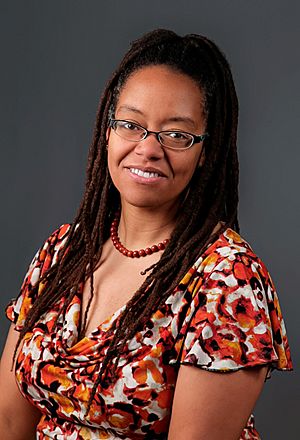Dara Norman facts for kids
Quick facts for kids
Dara J. Norman
|
|
|---|---|

Norman in 2023
|
|
| Alma mater | Massachusetts Institute of Technology, BS (1988) University of Washington, MS (1994) University of Washington, PhD (1999) |
| Scientific career | |
| Fields | Astronomy |
| Institutions | National Optical-Infrared Astronomy Research Laboratory |
| Doctoral advisor | [[Craig Hogan], [Chris Impey]] |
Dara J. Norman is a super cool astronomer! She helps lead the Community Science and Data Center at a big science place called the National Optical-Infrared Astronomy Research Laboratory (NOIRLab) in Tucson, Arizona. Dr. Norman is also the 50th president of the American Astronomical Society, which is a very important group for astronomers.
She used to be a special helper for diversity at NOAO. Her main research is about how something called Active Galactic Nuclei (AGN) affect how galaxies grow and change. In 2020, she became one of the first American Astronomical Society Fellows because of her amazing leadership and achievements in astronomy.
Contents
Becoming an Astronomer
Growing Up and Early Studies
Dara Norman grew up in Chicago, Illinois. She loved astronomy from a young age! Her mom was a big fan of science fiction and the United States Space program, which helped spark Dara's interest.
When she was a kid, she knew she wanted to be an astronomer. She went to the Massachusetts Institute of Technology (MIT) for college. There, she learned a lot from her mentor, Professor James Elliott. He was famous for leading the team that discovered the rings around the planet Uranus.
Dara has shared that college was tough at first. She felt anxious because she was taking many hard classes, like physics, electrical engineering, and even Japanese! But Professor Elliott's strong support helped her a lot. She earned her first degree in Earth, Atmospheric and Planetary Science in 1988.
Working at NASA and Graduate School
After college, Dara worked at NASA's Goddard Space Flight Center for three years. In 1992, she was showing her research at a meeting for astronomers. There, she met Bruce Margon, who was in charge of the Astronomy department at the University of Washington. She had just applied to go to graduate school there.
They talked about how they had both looked at the same active galaxy using the Hubble Space Telescope. Dara was accepted into the university's graduate program and started in the fall of 1992.
She earned her Doctorate degree in 1999. This was a big moment because she became the first African American woman to get her Ph.D. in astronomy from that university! For her Ph.D., she studied gravitational lensing and quasars. Gravitational lensing is when gravity from a huge object bends light, making distant objects look magnified or distorted. Quasars are super bright centers of galaxies.
After getting her Ph.D., Dara continued her research at Stony Brook University. Then, she became a special fellow with the National Science Foundation. She worked at the National Optical Astronomy Observatory (NOAO). In this role, she studied how galaxies appear magnified by gravitational lensing and how this affects our view of the universe.
Her Work Today
Researching Active Galaxies
Today, Dara Norman is an associate scientist and the deputy director of the Community Science and Data Center (CSDC) at NOIRLab. Her research now focuses on Active Galactic Nuclei (AGN). These are very bright, compact areas at the center of galaxies. Scientists believe they are powered by supermassive black holes.
AGN become bright when stars and gas fall into the supermassive black hole. They can shine even brighter than an entire galaxy full of stars! Dara's research tries to understand how these active galaxies form and why some of them are much brighter than others.
Helping Everyone in Science
Dara Norman is also a leader in making sure more people can work in science, especially in astronomy. She works to make science more diverse, fair, and welcoming for everyone. She was a special advocate for diversity at NOAO. In this role, she helped create plans to find and keep more minority groups and women in astronomy.
She also served on a committee for the American Astronomical Society that focused on minorities in astronomy. She has been an expert on panels for the National Academy of Sciences. These groups have written reports about helping women of color in universities and stopping harassment in science.
Dara works hard to make sure everyone has a chance to be involved. She believes that different groups should be represented on important committees. She also wants everyone to have access to large amounts of scientific data and the training needed to use it. She has pointed out that knowing how to code and work with data is becoming very important for astronomers. This is because data access is now often needed to get time on telescopes, which is key for astronomers to do their research and grow their careers.
Awards and Honors
- Distinguished Alumni Timeless Award, University of Washington, 2012
- Elected Legacy Fellow, American Astronomical Society, 2020
- Washington NASA Space Grant Fellowship

